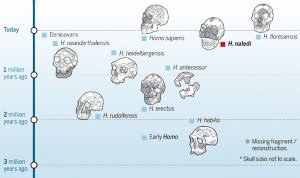Today’s post comes from Kirk Testa, class of 2019 and Art Center Docent
During my sophomore year, I assisted Dr. Patricia Phagan, the Loeb’s curator of prints and drawings, with research for the currently on view exhibition, Past Time: Geology in European and American Art
Tag Archives: pages.vassar.edu
Homo Naledi: A Surprisingly Modern Relative
In 2013, a deep, at some points very narrow cave system called Rising Star in South Africa produced bones that would be identified as a new addition to the Homo genus, named Homo naledi. The over 1,500 bones found, belonging to at least 15 individuals of varying ages, shared many traits with ourselves, such as the structure of their hands, wrists and feet, while also having many stark differences, including a much smaller brain that is closer to the Homo habilis (Hendry 2018). This mix of primitive and more modern features is curious, by not that surprising by itself, considering how complex the family tree is and how different members of the genus evolved in different ways.
The more surprising aspect of Homo naledi discovery is the age and location of the bones. To date the remains, the archaeologists who discovered the chamber first used radiometric dating on the flowstones, calcite deposited on the bones by running water that must have covered them at some point, and found that they were around 236,000 years old, meaning that the remains had to be older than that. After finding the minimum age, the team found the other end of the range by looking at how the cave’s natural radioactivity had affected the Homo naledi’s teeth by using electron spin resonance dating and estimated the maximum age to be around 335,000 years old (Greshko 2017). This dating makes the more primitive traits much more surprising because it means they were alive much closer to the time of Homo Sapiens than other members with similar brain sizes that lived millions of years ago (Figure 1), magnifying the complexity of the human’s already complicated evolution because it rejects the idea that brains have strictly gotten bigger and bigger as time has passed.
The placement of the bones was also puzzling considering the cave to get to the two chambers that were found is almost impossible to traverse, the chute (Figure 2) getting as narrow as 18 centimeters wide.
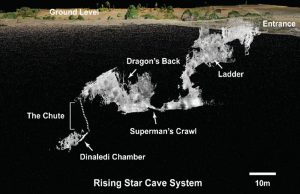
A cross section of the Rising Star cave system, showing the pathway that leads to the chamber that had most of the Homo naledi bones.
This brings up the question of why these individuals were brought into the cave system. A lack of marks on the bones and animal bones suggests that they were not dragged into the cave by any other animal (Zhang 2017), their own kind had most likely moved them. This kind of treatment of the dead is strange behavior for creatures with their smaller brains. While other animals today acknowledge their dead, navigating a complicated cave system, and probably having to use fire to do so (Hendry 2018), suggests a higher level of cognition and culture.
References
Greshko, Michael. “Naledi Fossils.” National Geographic, 9 May 2018, https://news.nationalgeographic.com/2017/05/homo-naledi-human-evolution-science/.
Hendry, Lisa. “Homo naledi, your most recently discovered human relative.” The Natural History Museum, 5 September 2018, http://www.nhm.ac.uk/discover/homo-naledi-your-most-recently-discovered-human-relative.html
Zhang, Sarah. “A New Addition to the Human Family Tree is Surprisingly Young.” The Atlantic, 9 May 2017, https://www.theatlantic.com/science/archive/2017/05/homo-naledi-age/525825/.
Images
https://medium.com/@johnhawks/renewed-excavations-in-the-rising-star-cave-ecb806f816d4
Additional Readings
https://daily.jstor.org/homo-naledi-and-paradigm-shift/.
Tracing Galena Artifacts at Poverty Point Back to their Source
The Poverty Point archaeological site in northeastern Louisiana is most widely known for its massive earthen mounds measuring up to 72 feet tall and forming six concentric semicircles. At its height from 1200 BCE to 700 BCE, the Poverty Point Native American site had an estimated population of around 5,000 and its advanced architecture and tools indicate a thriving society. Not only is Poverty Point an architectural wonder, it also serves as an indicator of a widespread trading network throughout the Midwest and Northeast. Stones and artifacts from as far as 1000 miles have been found by archeologists at Poverty Point.
When archeologists first began observing large amounts of stone artifacts at Poverty Point, they were able to identify the key element in many of the artifacts as galena, a shiny silver form of lead (II) sulfide. By 1970, over 700 artifacts containing galena had been identified at Poverty Point and four smaller surrounding settlements. The most common galena artifacts are bird effigy pendants, oval pendants, beads, and polished rectangles.
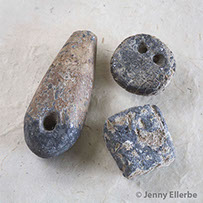
Galena has been found in a wide range of artifacts at Poverty Point including pendants, beads, polished rectangles and stones. Archeologists believe that these artifacts were often used for ceremonial and decorative purposes at Poverty Point as well as other Native American sites throughout the Southeast.
Archeologists used trace element analysis, the process of identifying elements present in small amounts, in order to trace a material back to its source of origin. Trace element analysis of galena artifacts at Poverty Point indicated that the majority of the rocks originated from the Potosi deposit in Missouri while others were from the upper Mississippi valley. Archeologists also conducted trace element analysis of galena artifacts at seven other Native American sites and found that 55% of the artifacts could be traced to the Potosi deposit and 34% to the upper Mississippi valley while the other 11% was inconclusive. Because of this evidence, archeologists were able to identify a trading pattern that used the Mississippi River, the Ohio River and the Arkansas River as well as the Ouachita stream and stopped at sites including Yazoo Basin and a Native American settlement at Calion.
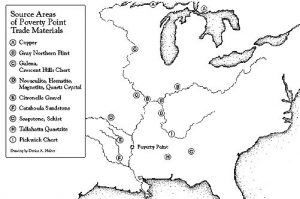
Galena was by no means the only material traded at Poverty Point. This map shows the source areas for other minerals found at Poverty Point in addition to the two main galena source points which are marked as A and C on this map.
Archeologists have also noted a highly similar style of bird pendants made from galena in four different locations along the Mississippi and Ohio Rivers indicate that galena was traded both as a raw material and as a finished product. This exhibits the shared cultural importance of galena while also indicating variations in cultural traditions.
Additionally, this trade is especially interesting to archeologists as it does not follow the theory of fall off analysis which states that the quantity of a material will decrease with the distance from the source of that material. There are many more galena artifacts at the Poverty Point site in Louisiana than there are at sites closer to the Potosi deposit. This indicates that the trade was not simply a reciprocal exchange, but rather a more complicated directional trading pattern. The Poverty Point trading network is one of the first instances of large scale long distance trade in the Americas that can be fully shown by archeologists. It represents an extremely important development in society as well as social organization.
Additional Readings:
Feasting at Poverty Point
Trace Element Analysis on Pottery from Oaxaca
References
Hays, Christopher T, Richard A Weinstein, and James B Stoltman
2016 Poverty Point Objects Reconsidered. Southeastern Archeology
Hill, Mark A, Diana M Greenlee, and Hector Neff
2016 Assessing the provenance of Poverty Point copper. Journal of Archaeological Science 6: 351–360
Louisiana Division of Archaeology
2014 Discover Archaeology. Louisiana Department of Culture, Recreation and Tourism
Walthall, John A, Clarence H Webb, Stephen H Stow, and Sharon I Goad
1982 Galena Analysis and Poverty Point Trade. Midcontinental Journal of Archaeology 7: 133–148
Image Citations:
Material Source Map. Louisiana Archaeology Project
https://www.crt.state.la.us/dataprojects/archaeology/virtualbooks/POVERPOI/trade.htm
Galena Artifacts. Louisiana Division of Archaeology
https://www.crt.state.la.us/dataprojects/archaeology/povertypoint/ceremonial-life.html
The Debunking of Androcentric Archaeology by the Priestesses of San José de Moro
When most people think of archaeology, the picture that comes to mind is more-often-than-not one closer to that of Indiana Jones than to that of Lara Croft. Despite both characters existing on a fictional spectrum, this observation of how such popular media culture is represented and absorbed by the general public is an example of a much bigger problem within the field of archaeology itself: androcentrism and the male bias.
Excavations of the Moche civilization in San José de Moro, Peru that inhabited the area between 1 CE and 800 CE have been taking place for decades. But in the past 27 years, up to eight notable tombs have been discovered in what was once thought of as a society consisting of only male warriors, priests, and kings. Tomb after tomb, archaeologists’ preconceived notions of the civilization’s societal composition were put to the test and quickly fell apart. In 2006, archaeologists were shocked to come across a lavishly decorated tomb on the El Brujo site filled with the remains of—you guessed it—a woman. The findings from a burial analysis of her mummified skeleton and the artifacts deposited in her grave—buried with wooden scepters wrapped in copper, a large crown with an image of a puma, and several tattoos symbolizing sacred figures including snakes, spiders, trees, and stars—led archaeologists to believe that she lived as a high priestess or even a queen of the Moche people. She was later referred to as the Lady of Cao, her burial’s discovery only to be followed by seven additional discoveries of other burial sites of women. The mummies adorned extravagant headdresses and beaded necklaces, were buried next to sacrificed victims, and were surrounded by grand artifacts including scepters and goblets that indicated that they, too, were of higher status and had possessed a more prominent role in the Moche society.

A reconstructed 3D-printed replica of the face of the Lady of Cao, a female priestess-queen of the Moche civilization.
The impact of androcentrism in archaeology is thoroughly and explicitly exemplified in the long-held assumption by archaeologists that the Moche society was ruled only by male figures; with further analysis of the burial sites, findings implied that the buried Moche women belonged to a higher social class, further breaking the notion that the Moche civilization exclusively comprised of higher orders of men and, rather, included—or more often comprised of—women as social elites.
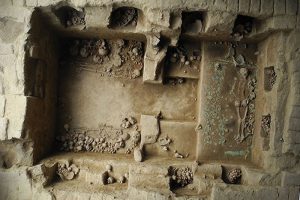
The tomb of the eighth Moche priestess to be discovered, buried 1,200 years ago with an array of artifacts that indicates her high social status.
The discoveries of the priestess-queens of the Moche remind us that we must stay aware of our presumptions and biases as they often bring us to incorrect conclusions. As archaeology is still developing when it comes to including, recognizing, and rewarding women, the male bias is especially important to keep in mind when considering historical archaeological conclusions about the role of gender in ancient societies and cultures. With an awareness of the biases of not only ourselves but also those of archaeologists before us, we can make sure that we are not discounting any potentialities on a matter of assumption or misinterpretation of evidence and that we are, instead, taking into consideration all possibilities in order to accurately restore the archaeological record.
Sources
Renfrew, Colin, and Paul Bahn 2010 Archaeology Essentials. 2nd ed. Thames & Hudson, New York.
Excavated Tombs of Peru’s Moche Priestesses Provide Archaeologists with Troves of Artifacts, Data
Lady of Cao Comes to Life: Face of Peruvian Priestess Reconstructed from 1,700-Year-Old Mummy
The Lady of Cao and the Royal Tomb Images Source
Additional Readings
Tomb of a Powerful Moche Priestess-Queen Found in Peru
1,500-year-old Ruins Shed Light on Peru’s Mysterious Moche People
Pollen Dating
Pollen dating, is one of the lesser utilized methods archaeologists have to determine a relative chronology or timeframe for a certain event. Pollen dating can determine a relative time frame far earlier than radiocarbon dating is able. Although, because of influences such as pollen transportation by wind for thousands of miles and the abundance of certain kinds of pollen, radiocarbon dating is necessary to give absolute dates.
Pollen dating is done by comparing the pollen zones in different rock layers or strata, comparing older, deeper layers to newer ones on top. The pollen zone is the particular time frame where specific species of plants release more pollen into the air than others. Using this, archeologists can determine climate changes, deforestation, or changes in the use of land hundreds of years ago such as the association between European settlement in North America and an increase in the amount of ragweed pollen found. Specific locations can even be determined as the origins for many rare or uncommon pollens.
Pollen can come in a variety of distinct shapes and sizes depending on the plant it is coming from. These microscopic grains are incredibly sturdy with outer shells made from sporopollenin, an incredibly inert substance. This allows the pollen to stay intact for thousands of years, especially when preserved in bodies of water, peat or, lake sediment. Ireland’s bogs are full of sediments and pollen, with certain layers linked to events such as the eruption of Icelandic volcanoes in 1104, 1362, and 1510 and an agricultural shift after the Black Death.
By looking at the sedimentary build up of pollen at the microscopic level, 400-1000x magnification, the pollen grains can be identified and the taxa concentrations determined, which can paint a picture of the climate as it changed over time.
Pollen can also be collected from the inside of pottery such as pots and stone tools, trapped in the fabric of clothes, the the cracks of floors and walls, or on other archeological artifacts and features. This can be used to help determine the diets of a people, their crops, and the materials they used to build their homes. By looking at these specific pollen samples as well as the layer of accumulated pollen, researchers can develop a better understanding of the environment and biodiversity throughout the history of an area.

Pollen magnified

Two researchers taking core samples
https://www.crowcanyon.org/index.php/palynology
Extra Links:
https://www.jstor.org/stable/20210068?seq=1#metadata_info_tab_contents
Citations:
Hirst, K. Kris. “How Does Palynology Inform Paleoenvironmental Reconstruction?” ThoughtCo, ThoughtCo, 8 Mar. 2017, www.thoughtco.com/palynology-archaeological-study-of-pollen-172154.
“Picture Climate: How Pollen Tells Us About Climate.” National Climatic Data Center, www.ncdc.noaa.gov/news/picture-climate-how-pollen-tells-us-about-climate.
The Irish Times. “Pollen Dating Paints Picture of Our Past.” The Irish Times, The Irish Times, 24 Feb. 2013, www.irishtimes.com/news/pollen-dating-paints-picture-of-our-past-1.365947.

